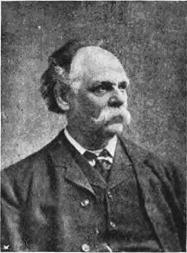Valentine Blanchard
Valentine Blanchard (1831 – 14 November 1901) was a prominent English photographer who was widely recognized for his artistic and technical contributions to photography in the 1860s. Both his landscape and his portrait photography were highly valued by the public, commanding high prices and selling well. He was much appreciated by his peers for the technical innovations he pioneered in photographic processes.[1][2][3][4]

Blanchard was born in Wisbech, Isle of Ely. Other Wisbech photographers included Samuel Smith (photographer) and Lilian Ream. According to Bill Jay, Blanchard "took stereoscopic pictures, cartes-de-visite, 'quality' portraits, instantaneous views, and art studies in platinum". He died in Meadow Lea, Herne Common, near Canterbury.
Early life
He was born and raised in Wisbech, the son of Lucy (nee Bates)(1794-1871 and Valentine Blanchard (b1790) a solicitor's clerk. [5]In 1851 the census records him living with his parents in Bedford street, Wisbech. [6] On completing an apprenticeship he moved to London.[7]
Career
By 1852 Valentine had completed his printing apprenticeship, moved to London and on 7 May 1854 he married Mary Ann Allen. About this time Valentine set out on a new career as a photographer, using the Daguerreotype process.[8] In 1869 he was in his studio at Camden Cottages, when the gun cotton and collodion he was working with caught fire and exploded. The blast destroyed his equipment and he received a hand injury.[9] By 1870 he was operating from a studio in Piccadilly before moving to Regent Street in 1876.[10] In the 1880s he ran six week afternoon photography courses 'Studio Posing and Lighting', evening courses using electric lighting and lectures on 'Art in Relation to Photography (Portraits and Groups)'. He is listed on the general committee of the Photographic Salon held between 1 October and 4 November 1894 in the Dudley Gallery, Piccadilly. This was the second salon organised by members of The Linked Ring.[11] His publications included A few plain words on carbon or pigment printing (1893), as well as articles in The British Journal of Photography and The Photographic News from 1862 to 1901.[12]
Later life
He died in 1901. An obituary was published in The British Journal of Photography. He was survived by a nephew Valentine Louis Blanchard, also a photographer with studios in Cambridge.[13][14]
Legacy
Images are held in collections including the J Paul Getty Museum and the National Portrait Gallery.
Further reading
Michael Millward and Brian Coe (1974). Victorian Townscape: The Work of Samuel Smith. Ward Lock Ltd.
References
- Henry Baden Pritchard (1882). "Mr. Valentine Blanchard in Regents Street". The Studios of Europe. E. & H. T. Anthony & Company. pp. 59–63. Retrieved 21 June 2014.
- William Crookes; George Shadbolt; William Blanchard Bolton; Thomas Bedding (1901). British Journal of Photography. H. Greenwood. p. 742.
- obituary, Practical Junior Photographer. 1902. p. 173.
- Solbert, Oscar N.; Beaumont, Newhall; Card, James G., eds. (April 1952). "Afield with the wet plate" (PDF). Image, Journal of Photography of George Eastman House, (Reprinted from the Practical Photographer, 1891). Rochester, N.Y.: International Museum of Photography at George Eastman House Inc. 1 (4): 2. Retrieved 21 June 2014.
- "Fenland's Valentines". www.issuu.com. Retrieved 6 February 2021.
- Monger, Garry (2021). "Fenland's Valentines". The Fens. Natasha Shiels. 57: 42-43.
- Somerville, Eric (2020). "Valentine Blanchard". Annual Report. Wisbech Society. 81: 14–19.
- "Valentine Blanchard". www.fadingimages.uk. Retrieved 19 January 2021.
- "The Other Evening". Christchurch Times. 11 December 1869. p. 5.
- Somerville, Eric (2020). "Valentine Blanchard". Annual Report. Wisbech Society. 81: 14–19.
- Photographic Salon 1894 catalogue
- leaflet
- "Valentine Blanchard". www.fadingimages.uk. Retrieved 31 December 2020.
- "Electric Light and Daylight Photogrphic Art Studios". Cambridge Independent Press. 19 February 1887. p. 4.
External links
- "Valentine Blanchard,1831–1901". www.whistler.arts.gla.ac.uk. Retrieved 19 June 2014.
- "Valentine Blanchard". Historic Camera. Retrieved 21 June 2014.
- "Blanchard, Valentime". PhotoLondon.org. Retrieved 21 June 2014.
